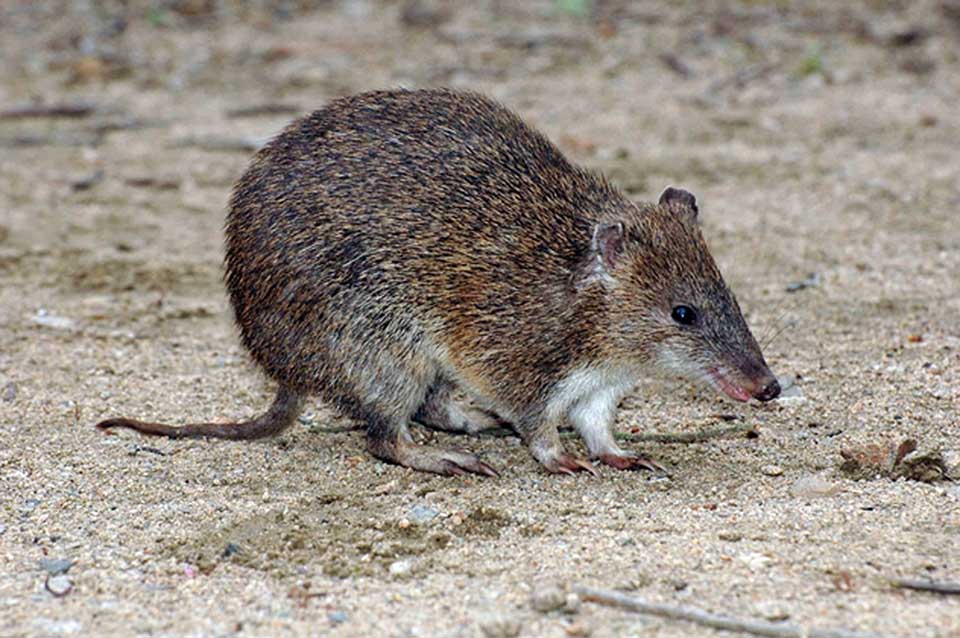
You know, I have always enjoyed the story about a child in an English primary school who was given a general knowledge written test which contained the question, “Where are elephants found?” The child, whose mind clearly worked in unusual ways, wrote “Elephants are extremely intelligent animals and rarely get lost.”
On the other hand, I suppose bandicoots get lost from time to time because they tend to be solitary creatures. In case you’d forgotten or possibly never knew, a bandicoot is a nocturnal animal which lives almost exclusively in Australia, Tasmania and New Guinea. They are usually grey or light brown in colour and because there are so many different types of bandicoot, they can range from 12 inches to 30 inches in length not including the tail. And (since you asked) the tail can add another four to twelve inches to the total length. From a distance, a bandicoot looks like a cross between a rat and a rabbit, except perhaps to another bandicoot. Like the kangaroo, the wombat and the koala, it’s a marsupial meaning that baby bandicoots spend the first few weeks of their lives in the female’s marsupium or pouch.
They are strangely attractive creatures, with big ears, a long tail and a pointed snout. They often hop around on their hind legs but when the mood takes them, they walk on all four. Being nocturnal, they emerge only at night and spent most of their time hunting and foraging for food. Despite their cute appearance, they don’t make terribly good pets because of their wild, unpredictable and hyperactive nature.
(Isn’t this supposed to be wine column? – Ed.) Oh heavens, I was getting rather carried away with the bandicoots. But there is a connection, because both the wines this week are named after bandicoots. They too come from Australia and I’ve been told that they’ve been selling remarkably well in Thailand. Last year alone, it seems that 18,000 bottles were sold here.
These are currently two of the cheapest wines on the market, so don’t expect them to taste like Château Margaux, or indeed Château-anything-else, but to my mind they’re decent everyday wines and jolly good value for money. They are evidently popular house wines at many hotels and restaurants.
 Bandicoot Estate Unoaked Chardonnay (white), Australia (Bt 325 @ Vines to Vino)
Bandicoot Estate Unoaked Chardonnay (white), Australia (Bt 325 @ Vines to Vino)
I first tried these two wines in March 2018, and looking back at my tasting notes I can see that they haven’t changed very much. Mind you, I would be surprised if they had, for this type of product is usually blended for consistency year in, year out. They’re known as non-vintage or simply “NV”. In case you’re wondering, “unoaked” means that the wine has not been stored in wooden oak barrels. The oak often brings toasty, buttery or vanilla-like flavours to the wine and many winemakers prefer to make a cleaner, lighter style by instead using stainless steel tanks.
This is a bright gold-yellow with an aroma that you associate with more expensive wine. It carries Chardonnay’s typical pineapple smells with fresh citrus fruit and there’s a hint of apple in the background. At 13% ABV, it’s a fresh, light-bodied and fruity dry wine, not as dry as the proverbial bone but dry nonetheless. There’s also a pleasing tang of acidity too which gives the taste a bit of definition. It would make an attractive apéritif to enjoy before the evening meal, but it would also go well with any light meals such as chicken salad or light fish dishes.
Bandicoot Estate Shiraz (red), Australia (Bt 325 @ Vines to Vino)
This is a rich, dark ruby-red with the characteristic Shiraz spicy, slightly jammy aromas of red and black fruit. It certainly smells more interesting than many other budget wines. I have to admit that I was expected a hefty, beefy wine but to their credit, the wine-makers have taken a more reserved approach. At 13.5% ABV, there’s plenty of dark fruit on the palate and just a mild touch of tannin to give a sense of firmness. As you’d expect, the wine is dry but the generous fruit helps to balance it out. The “finish” is the term used to describe the experience during the time the flavour lingers in your mouth after swallowing. Assuming that the flavour is pleasing and satisfying, a long finish is generally considered a good thing and this wine has just that, which is unusual for a wine at this price tag.
As to food, Shiraz is fairly versatile but to many people, it’s associated with the barbeque and this wine would work well with rich beef dishes or grilled meat. Normally, I prefer to drink a cheap Italian wine with pizza or pasta, but I tried the Bandicoot Shiraz with a home-made spicy pizza and the combination worked perfectly.
 |
 |
 |





